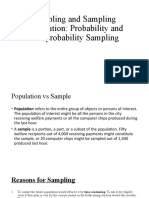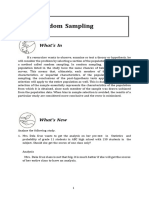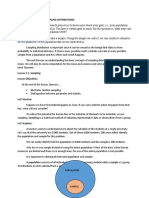0% found this document useful (0 votes)
317 views25 pagesSampling & Sampling Distribution: by Asif Hanif
This document discusses sampling and sampling distributions. Some key points:
- Sampling involves taking a subset of a population to make inferences about the population. It is more efficient than studying the entire population.
- Probability sampling methods like simple random sampling, stratified sampling, and cluster sampling aim to select a representative sample. Non-probability methods do not aim for representativeness.
- The sampling distribution of a statistic like the sample mean describes the range of possible values it could take from all possible samples of the same size. It allows us to understand sampling error and make statistical inferences.
Uploaded by
sadia245Copyright
© Attribution Non-Commercial (BY-NC)
We take content rights seriously. If you suspect this is your content, claim it here.
Available Formats
Download as PPT, PDF, TXT or read online on Scribd
0% found this document useful (0 votes)
317 views25 pagesSampling & Sampling Distribution: by Asif Hanif
This document discusses sampling and sampling distributions. Some key points:
- Sampling involves taking a subset of a population to make inferences about the population. It is more efficient than studying the entire population.
- Probability sampling methods like simple random sampling, stratified sampling, and cluster sampling aim to select a representative sample. Non-probability methods do not aim for representativeness.
- The sampling distribution of a statistic like the sample mean describes the range of possible values it could take from all possible samples of the same size. It allows us to understand sampling error and make statistical inferences.
Uploaded by
sadia245Copyright
© Attribution Non-Commercial (BY-NC)
We take content rights seriously. If you suspect this is your content, claim it here.
Available Formats
Download as PPT, PDF, TXT or read online on Scribd
/ 25























































































